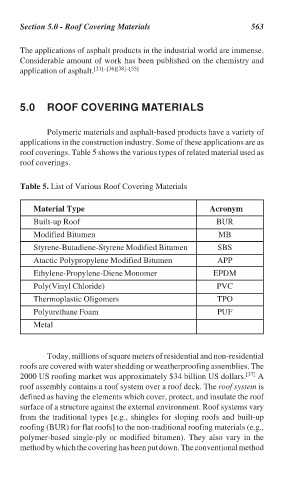Page 596 - Handbook of Thermal Analysis of Construction Materials
P. 596
Section 5.0 - Roof Covering Materials 563
The applications of asphalt products in the industrial world are immense.
Considerable amount of work has been published on the chemistry and
application of asphalt. [31]–[36][38]–[55]
5.0 ROOF COVERING MATERIALS
Polymeric materials and asphalt-based products have a variety of
applications in the construction industry. Some of these applications are as
roof coverings. Table 5 shows the various types of related material used as
roof coverings.
Table 5. List of Various Roof Covering Materials
Material Type Acronym
Built-up Roof BUR
Modified Bitumen MB
Styrene-Butadiene-Styrene Modified Bitumen SBS
Atactic Polypropylene Modified Bitumen APP
Ethylene-Propylene-Diene Monomer EPDM
Poly(Vinyl Chloride) PVC
Thermoplastic Oligomers TPO
Polyurethane Foam PUF
Metal
Today, millions of square meters of residential and non-residential
roofs are covered with water shedding or weatherproofing assemblies. The
2000 US roofing market was approximately $34 billion US dollars. [37] A
roof assembly contains a roof system over a roof deck. The roof system is
defined as having the elements which cover, protect, and insulate the roof
surface of a structure against the external environment. Roof systems vary
from the traditional types [e.g., shingles for sloping roofs and built-up
roofing (BUR) for flat roofs] to the non-traditional roofing materials (e.g.,
polymer-based single-ply or modified bitumen). They also vary in the
method by which the covering has been put down. The conventional method

